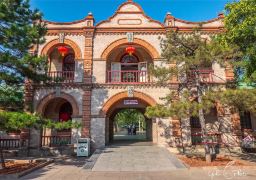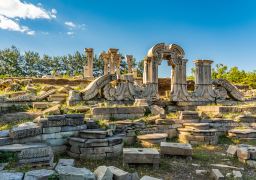The Porcelain House is a French-style building decorated with countless privately collected ancient porcelain, white marble stone carvings, crystals, agates and antiques. The walls of the house are densely covered with exquisite ancient Chinese porcelain. The courtyard and the building are filled with antiques. The overwhelming porcelain antiques often dazzle tourists who first arrive at the Porcelain House.
The wall of the Porcelain House is formed by stacking and connecting hundreds of ancient porcelain vases from the period of the Republic of China and the late Qing Dynasty, named Ping’an Wall. The roof is a pattern of ‘China’ coiled by a giant dragon made of ancient porcelain pieces. Behind the giant dragon is the Bird’s Nest, the main stadium of the 2008 Olympics, made of broken porcelain pieces. Pay attention to the right side of the periphery of the house. There is a vertical row of porcelain cats extending from the top floor to the corner of the first floor. The porcelain cats are inlaid with crystals and agates. But such an elaborate decoration is actually a sewer pipe, which is amazing. The whole building has five floors. The basement is not open to the public. The first to fourth floors are for tourists to visit. On each floor, there are many exquisitely carved ancient wooden furniture. On the red walls, celebrity calligraphy and paintings at all times and in all countries are pasted with porcelain pieces. In the middle of the first floor is a large porcelain vat of the Song Dynasty. There are balconies on the second and third floors for viewing. Be sure to look up at the ceiling of the balcony. The ceiling is pasted with whole ancient porcelain plates. The plates closer to the middle are more valuable. Since the middle of each floor is hollowed out, you can see the large porcelain vat in the middle of the first floor from the fourth floor. Facing the Porcelain House, on the left side, there is a small room also covered with exquisite porcelain, which is the toilet. Just take a look. In order to use an elegant and beautiful toilet among crystals, agates and porcelain piles, there is often a long queue in front of the toilet. On the right side of the Porcelain House is the exit. Don’t go out directly. The small room where the exit is located has the ‘treasure of the museum’. Some of the antique stone statues seen in the courtyard of the Porcelain House have no heads. The heads are all in the side room at the exit. Among them, the larger Buddha head is the ‘treasure of the museum’. There is a large groove on the eyebrow of the Buddha, which was originally used for placing rubies. Photography is not allowed in this room at the exit. If just looking at this Porcelain House is not enough, there is a Geda House (No. 283, Hebei Road) in the Five Avenues of Tianjin. It has similar charm to the Porcelain House and is not far away. You can go and have a look.The Porcelain House offers free admission to children under 2 meters in height.
Disabled individuals: Admission is free with a disability certificate. Journalists: Admission is free with a valid press credential. Tour guides: Admission is free for group tour guides with a guide license. Monks: Admission is free with relevant documentation. Faculty/University Students: Faculty and students from Tsinghua University, Peking University, Nankai University, and Wenzhou University enjoy free admission. Service Facilities: The Porcelain House Visitor Center provides free guided tours for visitors.








